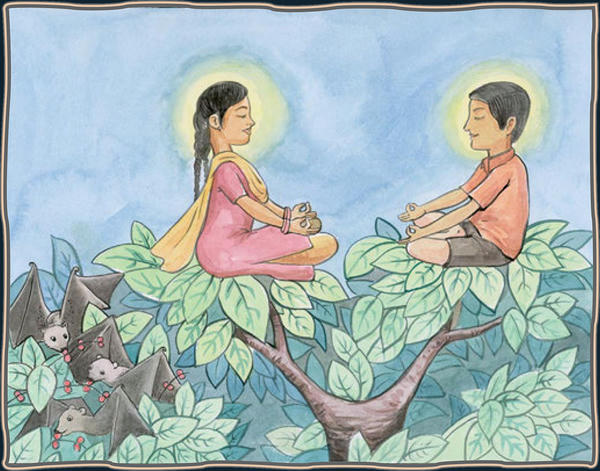
At last, brother and sister reach the top of the banyan, and sit together in silent bliss. Their efforts have brought them to a oneness with the universe as they dive deeply within to discover they are that universe, they are the Self within each other, and within all. A family of bats feeds among the leaves of the tree. Just as bats forage while others sleep, so too do our young yogis seek a greater consciousness which remains asleep in most others.§
Out of meditation, we come into contemplation. Contemplation is concentrating so deeply in the inner areas of the mind in which that flower and the species of it and the seed of it and all exist. We go deeper, deeper, deeper within, into the energy and the life within the cells of the flower, and we find that the energy and the life within the cells of the flower is the same as the energy within us, and we are in contemplation upon energy itself. We see the energy as light. We might see the light within our head, if we have a slight body consciousness. In a state of contemplation, we might not even be conscious of light itself, for you are only conscious of light if you have a slight consciousness of darkness. Otherwise, it is just your natural state, and you are in a deep reverie. In a state of contemplation, you are so intently alive, you can’t move. That’s why you sit so quietly. This is savikalpa samādhi (“union with form or seed”), identification or oneness with the essence of an object. Its highest form is the realization of the primal substratum or pure consciousness, Satchidānanda.§
This, then, leads to the very deepest samādhi, where we almost, in a sense, go within one atom of that energy and move into the primal source of all. There’s really nothing that you can say about it, because you cannot cast that concept of the Self, or that depth of samādhi, you cannot cast it out in words. You cannot throw it out in a concept, because there are no areas of the mind in which the Self exists, and yet, but for the Self, the mind, consciousness, would not exist. You have to realize It to know It; and after you realize It, you know It; and before you realize It, you want It; and after you realize It, you don’t want It. You have lost something. You have lost your goal for Self Realization, because you’ve got it. This is nirvikalpa samādhi (“union without form or seed”), identification with the Self, in which all modes of consciousness are transcended and Absolute Reality, Paraśiva, beyond time, form and space, is experienced. This brings in its aftermath a complete transformation of consciousness.§
The Chandogya Upanishad expresses it so beautifully: “The Self is below, above, behind, before, to the right, to the left. I am all this. One who knows, meditates upon and realizes the truth of the Self—such a one delights in the Self, revels in the Self, rejoices in the Self. He becomes master of himself and master of all the worlds. Slaves are they who know not this truth.” (7.25.2 The Upanishads, Prabhavananda and Manchester, p. 118).§

